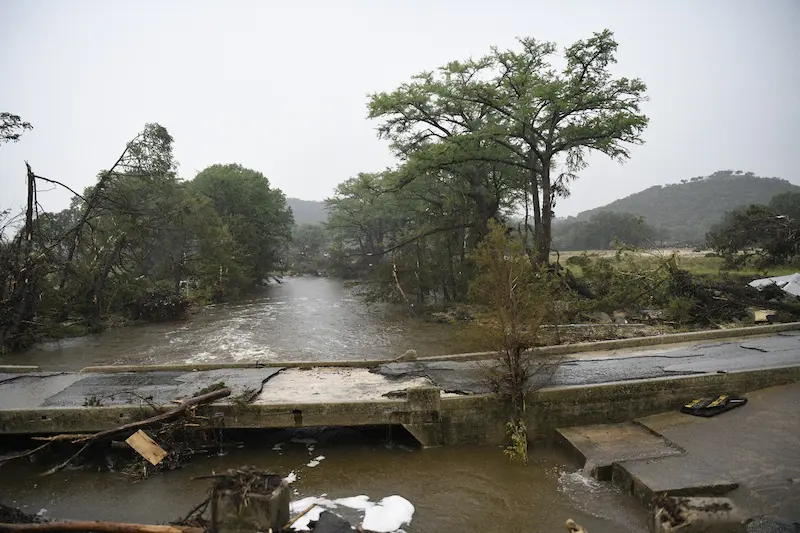
Tragic floods in Central Texas have claimed over 130 lives and displaced thousands in July 2025.
A Storm Unlike Any Other: What Happened?
Central Texas Flood Disaster – In mid-July 2025, Central Texas was battered by relentless rainstorms, the likes of which hadn’t been seen in decades. Flash floods overwhelmed riverbanks, drainage systems failed, and entire neighborhoods were submerged within hours. Meteorologists noted the severity was fuelled by a rare confluence of tropical moisture and stalled weather systems, resulting in rainfall totals exceeding 20 inches in under 48 hours in several counties.
The cities of Austin, Waco, and Temple were among the hardest-hit. Rural areas, with limited flood management infrastructure, faced even greater devastation.
Death Toll and Displacement: The Human Cost
With the Texas death toll surpassing 130, and more expected as search operations continue, the tragedy has shaken communities to their core. Over 18,000 residents were evacuated, and makeshift shelters now house thousands. Stories of stranded families, missing persons, and harrowing rescue efforts dominate local news cycles.
Emergency personnel, volunteers, and even neighbors formed human chains to pull people from submerged vehicles and collapsing homes. Drones and thermal imaging devices have become essential in locating survivors.
Underlying Causes: Is Climate Change to Blame?
While flooding in Texas is not new, the magnitude of this disaster has led experts to revisit long-standing concerns about climate change and urban development:
- Climate Volatility: Warmer air holds more moisture. Extreme rainfall events have become more frequent due to rising global temperatures.
- Poor Urban Planning: Rapid development in floodplains over the past decade has left communities vulnerable.
- Aging Infrastructure: Many flood control systems in Texas were designed decades ago and were not built to withstand such intensity.
This isn’t simply a natural disaster, it’s an intersection of human decisions, climatic shifts, and systemic underinvestment.
Texas disaster relief – Government Response and Federal Aid
FEMA response Texas – President Donald Trump has declared a federal emergency, unlocking millions in disaster relief funds. The Federal Emergency Management Agency (FEMA) has deployed rapid-response teams, engineers, and medical support units.
Here’s a breakdown of the current initiatives:
| Response Agency | Role | Progress |
| FEMA | Relief distribution, damage assessment | Over 2,400 families aided |
| National Guard | Evacuation & search ops | 9,000 missions flown |
| Red Cross | Shelter & psychological support | 80 shelters active |
| Local Governments | Coordinating clean-up | Infrastructure mapping underway |
While aid is flowing, many residents have criticized the delay in early warnings, as flood alerts came hours after rains had already begun inundating the region.
Stories from the Ground
Amid the devastation, the resilience and humanity of affected communities have shone through:
“My entire home is gone, but my neighbor got me out before the roof collapsed,” said Maria Gutierrez, a schoolteacher from Bell County.
Local churches, mosques, and synagogues have opened their doors. Food banks are operating round-the-clock. Small businesses are donating supplies, and private citizens are using boats to ferry stranded individuals.
These powerful stories highlight both the loss and the deep wells of empathy that disasters often uncover.
Lessons Learned: What Needs to Change?
As Central Texas begins its long path to recovery, experts and policymakers are advocating for sweeping changes:
- Modernized Flood Infrastructure: Upgrade levees, dams, and urban drainage systems.
- Revised Zoning Laws: Prevent development on high-risk flood zones.
- Climate Adaptation Strategies: Build resilient cities that consider future climate scenarios.
- Community Education: Regular drills, flood mapping, and local preparedness programs.
Without these, future floods might not just repeat they might worsen.
Rebuilding Texas: A Call to Action
Recovery isn’t just about rebuilding what was lost, it’s about creating something stronger. Architects are talking about elevated housing, emergency tech startups are offering real-time alert systems, and civil engineers are working on permeable roads that absorb rainfall.
The flood of 2025 may go down as one of the worst in the state’s history, but it could also be the moment that pushes Texas into a new era of environmental foresight and infrastructural renewal.
In Solidarity, Hope Endures
Natural disasters can feel senseless and overwhelming. Yet, it’s often in the wake of such events that we find our greatest reservoirs of strength. Central Texas has endured unimaginable loss, but the response both official and grassroots, reveals a community committed to caring, rebuilding, and preparing for what’s ahead.
As we watch recovery unfold, the message is clear: when nature tests us, unity becomes our greatest asset.
What caused the Central Texas Flood in July 2025?
The flood resulted from a rare mix of stalled weather systems and tropical moisture, bringing over 20 inches of rain to the region in less than 48 hours. Poor urban planning and aging infrastructure compounded the disaster.
Which areas were most affected by the Texas flood?
Cities like Austin, Waco, and Temple, along with surrounding rural counties, were severely impacted due to overwhelmed drainage systems and proximity to swelling rivers.
How is the government responding to the Texas flood disaster?
President Trump declared a federal emergency, prompting FEMA, the National Guard, and local agencies to deploy rescue operations, temporary shelters, and financial aid packages for survivors.
Is climate change being blamed for the flood?
Yes, experts cite increasing rainfall intensity due to warming atmospheric conditions and a lack of adaptive infrastructure as contributing factors to the flood’s severity.
What measures are proposed to prevent future flooding?
Recommendations include modernizing flood-control infrastructure, revising zoning laws, implementing climate adaptation plans, and enhancing community preparedness through education and real-time alert systems.
Stay updated with the latest news on Rapido Updates. Keep yourself updated with The World, India News, Entertainment, Market, Automobile, Gadgets, Sports, and many more